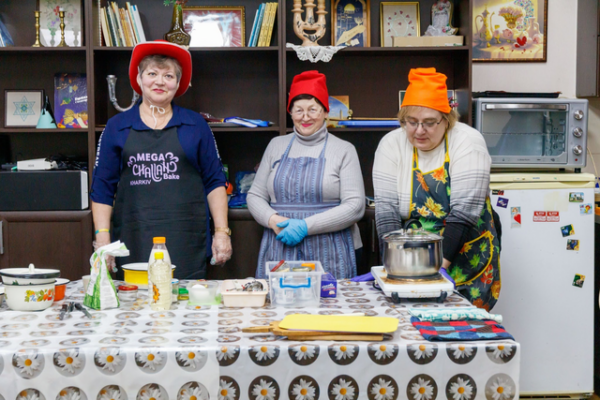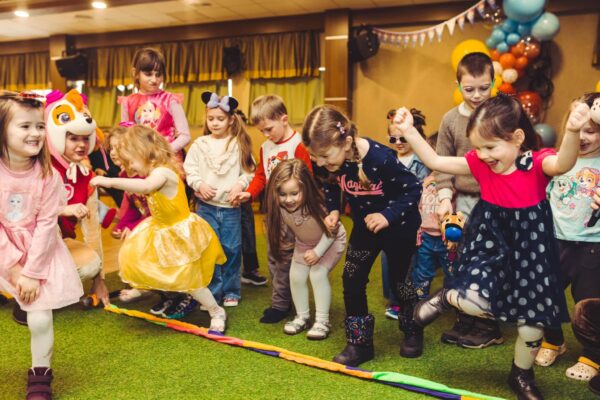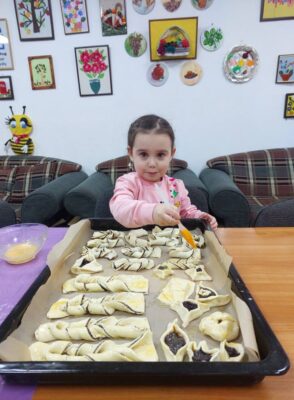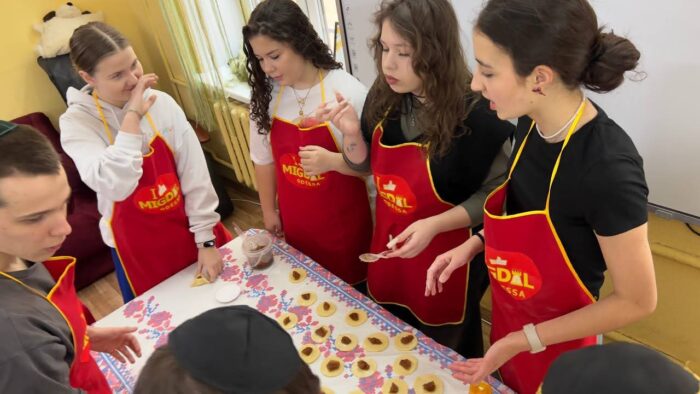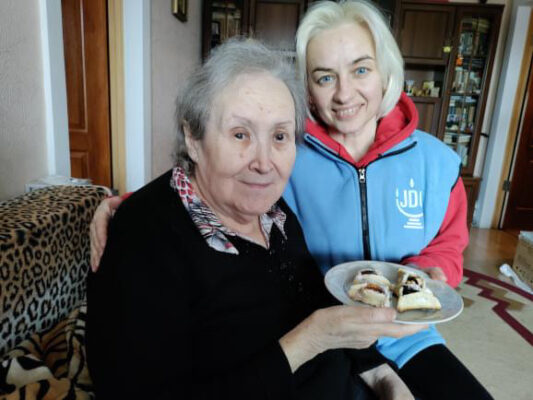The Purim story is a powerful reminder of the Jewish people’s resilience and survival in the face of adversity — and it’s a story whose themes have echoed in JDC’s work for more than 110 years. From Buenos Aires to Budapest, Ukraine to Israel, and beyond, JDC ensures that no matter what challenges Jews and Israelis face, they will have the necessary strength and support to face whatever comes next.
For Jews everywhere, Purim is a vibrant Jewish holiday that celebrates the story of Esther, a courageous Jewish woman who saved her people from annihilation in ancient Persia. Celebrated annually on the 14th day of the Hebrew month of Adar, Purim is a time of joy, festivity, and community.
During the Purim holiday, Jews gather to read the Book of Esther (otherwise known as the Megillah), exchange gifts of food, donate to charity, and enjoy festive meals. Celebrants also wear costumes and masks and give small treats called mishloach manot to friends and family. Above all, Purim celebrates unity, gratitude, and the enduring spirit of the Jewish people.
The Purim Story
The Purim story centers around Queen Esther, who was chosen to be the wife of King Ahasuerus after he expelled his previous wife, Vashti. Soon after, Haman, an advisor to the king, devised a plan to annihilate the kingdom’s entire Jewish population. Esther, risking her life, revealed her Jewish identity to the king and pleaded for the survival of her people, ultimately saving the Jewish community through her bravery and intelligence.
Key figures in the Purim story include Mordechai, Esther’s guardian, who played a crucial role in uncovering the plot against the Jews and encouraging Esther to reveal herself. Haman, the antagonist, sought to eliminate the Jewish people but faced a well-deserved downfall. King Ahasuerus, initially indifferent, played a pivotal role in its resolution.
What is the History of Purim?
Purim is a Jewish holiday that commemorates the events described in the Book of Esther and dates back to the 4th century BCE during the Persian Empire.
Over time, Purim celebrations have evolved and become more festive. Traditionally, the holiday is marked by reading the Megillah, which recounts the events of Purim. During the reading, it is customary to drown out Haman’s name with noisemakers called groggers.
The Purim holiday is celebrated with joyous festivities, including dressing up in costumes, often resembling characters from the Purim story. Special foods like hamantaschen — triangular pastries filled with sweet fillings — are enjoyed during the holiday.
Even in challenging times, Purim celebrations have continued — a testament to the resilience, joy, and determination of the Jewish people.
What is the History of Purim?
One central custom is the reading of the Megillah. It’s often read aloud in synagogues, and every time Haman’s name is mentioned, people boo and use their groggers to drown out his memory. This tradition serves as a reminder to stand up against evil and injustice.
Purim also involves the giving of gifts and charity. It is customary to exchange mishloach manot (Purim gift baskets) with friends, family, and neighbors. These gifts often include sweets, fruits, and other traditional treats. Additionally, matanot l’evyonim (donations to the poor) are encouraged as a way to share the joy of the holiday with those in need.
Purim is also a time for festive gatherings and celebratory meals. Families and friends come together to share a special feast, often including hamantaschen. These meals are accompanied by singing, dancing, and even costume parties.
Celebrating Purim is not only about remembering the past but also about reinforcing community bonds and spreading joy. It’s a time to express gratitude, perform acts of kindness, and come together in celebration.
What Are Some Purim Traditions and Customs?
Dressing up in costumes and masks: One of the most exciting aspects of Purim is the tradition of wearing costumes and masks. This custom is rooted in the idea that during the events of the Purim story, God’s presence was hidden, and miracles happened in disguise. People of all ages, from children to adults, dress up as characters from the Purim story, superheroes, animals, and even pop culture icons.
Exchanging mishloach manot: Another cherished tradition of Purim is the exchange of mishloach manot. These baskets typically contain an assortment of sweets, snacks, and drinks. The act of giving and receiving these gifts promotes unity, friendship, and acts of kindness within the community. It’s customary to send at least two different types of food or drink to at least one person, emphasizing the importance of sharing and caring for others.
Reading the Megillah aloud: The centerpiece of Purim is the public reading of the Megillah. This ancient story describes how Queen Esther and her guardian Mordecai saved the Jewish people from Haman’s evil plan. When the Megillah is read aloud in synagogues, congregants participate by cheering, booing, and using noisemakers called groggers whenever Haman’s name is mentioned. It serves as a reminder of the triumph of good over evil and the importance of standing up for one’s beliefs.
When is Purim Celebrated?
Purim is celebrated on the 14th day of the Hebrew month of Adar, which usually falls in late February or early March in the Gregorian calendar.
The holiday lasts for one day, beginning at sundown the night before and ending at sundown the following day. In Jerusalem and other ancient walled cities, Purim is celebrated on the 15th day of Adar, known as Shushan Purim. Each year, Purim falls on the same date in the Jewish calendar, but it varies in the English calendar.
While the date of Purim is determined by the Jewish calendar, the way it is observed can vary between different Jewish communities. Some communities may have unique customs or traditions associated with the holiday, such as special foods, costumes, or plays. However, Purim’s core themes of resilience, persistence, and unity are shared by Jews everywhere.




